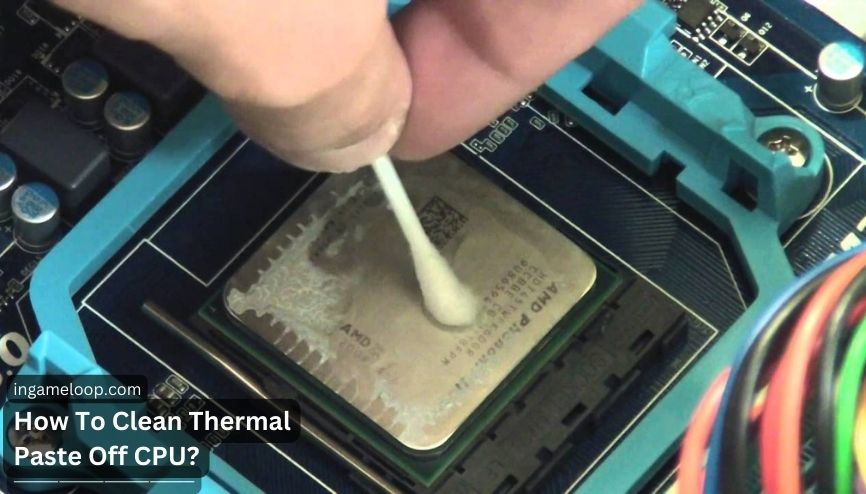
Thermal paste isn’t a part of a computer but is a necessary addition to some computer components like processors and heatsinks to perform certain operations. It is a unique chemical compound that acts as an insulator between heat sinks and heat sources to transfer heat and enhance heat dissipation effectively. You can’t use the CPU without thermal paste since it may cause overheating and affect the CPU’s performance. Therefore, you must know what thermal paste is and how we can use it to purchase a good one and get the most out of the PC.
If you’re interested in upgrading the thermal paste, you have to remove the older one before its application. In addition, knowing how to clean thermal paste off CPU is one of the crucial steps to proceed with our ultimate goal and doing everything right. Therefore, we have written this post to help you out through the process. You need to have specific items to help you remove the older thermal paste, and those steps are given in the below section. Grab these items, plus read all the crucial steps before preceding the process—those steps are also given below.
Tools we need to clean thermal paste
We need some tools to clean the thermal paste off without damaging the component. Those include as following:
| Tools | Why do we need them? |
| Microfiber cloth | Microfiber cloth comes from a polyester and nylon blend. It is much better for cleaning matters like dirt, oils, and grease. The risk of scratching is relatively less with it. |
| Isopropyl alcohol | It is best used for disinfecting surfaces. With the help of Isopropyl alcohol, thermal paste is easy to clean since it is the most effective one. |
| Toilet paper | Toilet paper is not as soft as a microfiber cloth but is a solid alternative to remove the tough thermal paste. |
| Cotton Swabs | Cotton swabs are very easy to use when fingers can’t reach a particular area and are also very useful for finishing touches. |
| Thermal Paste | Thermal paste is an insulator between heat sinks and heat sources. You must have a new thermal paste when the older one is removed to replace it with a new one. |
How to clean thermal paste off CPU?
The process of cleaning the expired thermal paste comprises certain stages: preparing the components for the procedure, removing the thermal cooler, and actually cleaning the thermal paste off. Therefore, we will discuss each stage and the steps for each stage in the sections below. Be with me until the end of all the stages to effectively clean the paste without damaging any part or wasting your time doing unnecessary things. Let’s explore.
Stage 1: Prepare all the components.
If you have gathered the above items, it’s time to proceed next—follow these steps before removing the thermal paste.
- Step 1: Shut down the computer with the start button.
- Step 2: Unplug all the power cables from the computer.
- Step 3: Unplug the CPU fan cooler wire from the motherboard.
Stage 2: Remove the CPU Cooler
To upgrade your CPU’s thermal paste, it’s necessary to remove the CPU cooler first from your PC. To do so, untie all the screws located at each corner of the CPU cooler. When all screws are removed, gently pull up the cooler from the motherboard without hitting or touching it with the other components. On the other hand, removing the liquid coolers may be a bit different. They usually have four screws at the corners, along with the radiator attached to the computer case. Be careful when removing the liquid cooler.
Stage 3: Start cleaning the thermal paste
- Step 1 — Grab a little bit of toilet paper: When the cooler is removed, it’s time to clean the CPU’s thermal paste. Grab a little bit of toilet paper and use it to wipe the paste on the CPU’s top as much as possible.
Note: Some thermal paste is dry and may be difficult to clean with toilet paper.
- Step 2 — Add some isopropyl alcohol: To clean in such a scenario, add a small amount of isopropyl alcohol to a microfiber cloth, and wipe the CPU from top to bottom until there is no visible thermal paste. Make sure that all the corners are cleaned.
Note: If a small amount of thermal is left on the CPU surface, it could potentially damage the CPU. Don’t forget to clean off any thermal paste stuck in the heatsink. You can use cotton swabs for that purpose.
- Step 3 — Let the CPU dry: The amount of time the paste takes to dry depends upon the solution’s nature and varies from solution to solution. Generally, the CPU dries in one hour. But I suggest you read the instructions on the menu and find the proper time.
How to apply thermal paste?
In this section, we’ll teach you to reapply for new thermal paste, which is one of the critical steps to proceed with our ultimate goal. There are several methods to apply new thermal paste, that’s why it may be a touchy subject among fantastic users—you can read this in-depth post on how to apply the thermal paste as well to understand the topic deeply. If you don’t have much time, follow the steps below to apply the new thermal paste. These steps are given below the section.
Following the Dot Method
In this method, we simply put some dot of paste on the CPU. This method guarantees an excellent performance, and even thermal paste spread is relatively proportional in all CPU areas.
- Step 1: Take your thermal paste and put a small amount or dot of the paste on the center of your CPU.
Note: Don’t put too much thermal paste on the CPU. The required amount could be the size of a pea or grain of rice. Don’t exceed the limit; otherwise, you will be sacrificing your CPU performance.
- Step 2: Now take the CPU cooler, install it correctly on the processor, and make sure your cooler is on as straight as possible the first time. This will allow the paste to spread equally.
- Step 5: Hold it at its correct position while screwing it on the motherboard.
Conclusion
Thermal paste can be difficult to remove if you don’t have the correct type of tools. It can be challenging to perform if you don’t have the correct type of tools plus guidance to remove the paste in the right way. Maintaining your thermal paste properly is necessary to keep your CPU cool and healthy and perform its duties without any issues. The most important part of the process is to know how to clean the thermal paste off CPU and reapply it again while following all the essential steps.
To make things easy, we have written a step-by-step guide about all the necessary steps to remove and apply the thermal paste. Firstly, make sure to collect all the required items that you need to remove the paste. Then, read all the steps given in the earlier section, remove the paste carefully, and reapply the new paste. After that, wait for the required amount of time to let the paste dry so it won’t cause any issues in the future. Now, assemble everything, and you’re good to go and use the computer.
Frequently Asked Questions
How long does unused thermal paste last?
Thermal paste generally takes three to four years to turn into a bad state. It also depends on the brand and production date. But, if you have applied thermal paste on a gaming PC, there is a possibility that thermal paste dries up soon.
Can I use paper towels to clean the thermal paste?
The answer is yes—you can use a paper towel or toilet paper to remove the thermal paste. But we advise you to use a microfiber cloth since it reduces the risk of scratching—if you don’t have a microfiber cloth, you can use coffee filter paper as an alternative.
Can I clean the thermal paste without isopropyl alcohol?
If you’re not from the 90+ percent of enthusiasts that use isopropyl alcohol, you can use nail varnish remover to clean the thermal paste from the CPU. Remember, you must use it the same way as you do for isopropyl alcohol.



![Is an Intel Celeron Processor Good? [2024]](https://www.ingameloop.com/wp-content/uploads/Is-an-Intel-Celeron-Processor-Good-450x257.jpg)


![What CPUs are Compatible with my Motherboard? [2024]](https://www.ingameloop.com/wp-content/uploads/What-CPUs-are-compaitble-with-my-Motherboard-450x257.jpg)